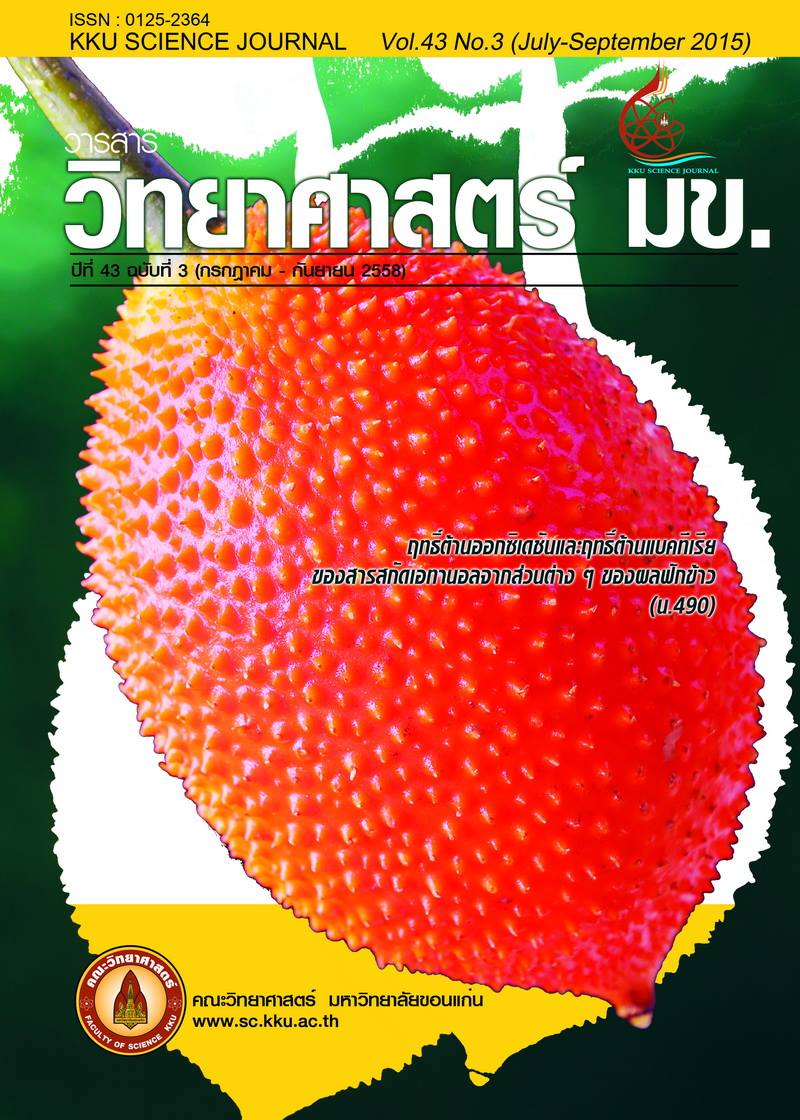ผลของสารเคมีป้องกันกำจัดศัตรูพืชต่อการเจริญและประสิทธิภาพของเชื้อราขาว Beauveria bassiana (Balsamo) Vuillemin ในการควบคุมเพลี้ยแป้งสีชมพูมันสำปะหลัง
Main Article Content
บทคัดย่อ
การทดสอบผลของสารเคมีป้องกันกำจัดศัตรูพืชได้แก่ สารกำจัดแมลง (thiamethoxam, amitraz) สารป้องกันกำจัดเชื้อราโรคพืช (mancozeb, benomyl) และสารกำจัดวัชพืช (paraquat dichloride) ต่อการเจริญของเชื้อราขาว Beauveria bassiana และประสิทธิภาพในการควบคุมเพลี้ยแป้งสีชมพูมันสำปะหลัง
(Phenacoccus manihoti) ส าหรับผลต่อการอยู่รอดของสปอร์พบว่า การน าเชื้อราขาวความเข้มข้น 1×104 และ 1×105 สปอร์/มล. มา spread ลงบนอาหารที่มีส่วนผสมของสารเคมีดังกล่าว ตรวจสอบการงอกของสปอร์ที่เวลา 1 และ 3 วัน นั้น เชื้อที่ความเข้มข้น 1×105 สปอร์/มล. ตรวจผล 1 วัน กรรมวิธีควบคุม (อาหาร PDA ไม่ผสมสารใด ๆ) มีการเจริญของเชื้อราสูงที่สุด (444.33 cfu/plate) แตกต่างทางสถิติ (P<0.05) กับกรรมวิธีอื่น ๆ ส่วนในกรรมวิธีที่ผสม PDA กับสารเคมีต่าง ๆ นั้น เฉพาะ PDA+ thiamethoxam เท่านั้นที่มีการเจริญของเชื้อราขาว (185.33 cfu/plate) ส่วนเชื้อที่ความเข้มข้น 1×104 สปอร์/มล. ตรวจสอบการเจริญหลังการเพาะเลี้ยงเชื้อ 3 วันนั้น การเจริญของเชื้อสูงที่สุดพบในอาหาร PDA+thiamethoxam (269.00 cfu/plate) แต่ไม่แตกต่างทางสถิติกับ
กรรมวิธีควบคุมที่มีค่ารองลงมาเท่ากับ 252.60 cfu/plate ขณะที่เชื้อราที่เลี้ยงในอาหาร PDA+amitraz (166.80 cfu/plate) และ PDA+ paraquat dichloride (145.00 cfu/plate) มีค่าใกล้เคียงกันและไม่แตกต่างกันทางสถิติ ส่วนผลต่อการเจริญของเส้นใยนั้น เชื้อจะเจริญเพิ่มขึ้นตามอายุที่เพิ่มขึ้น ซึ่งเชื้อราที่เลี้ยงในอาหาร PDA+thiamethoxam มีเส้นผ่าศูนย์กลาง (Ø) การเจริญในวันที่ 7 (Ø 2.72 ซม.) และวันที่ 14 (Ø 4.67 ซม.) ไม่แตกต่างทางสถิติกับกรรมวิธีควบคุม (Ø 2.72 และ 5.32 ซม. ตามลำดับ) เฉพาะ PDA+benomyl เท่านั้นที่เชื้อไม่สามารถเจริญได้ และเมื่อนำสปอร์ของเชื้อราขาวที่ได้จากการเพาะเลี้ยงด้วยอาหาร PDA+สารเคมีป้องกันกำจัดศัตรูพืชที่สามารถเจริญได้ดีมาทดสอบประสิทธิภาพในการเข้าทำลายเพลี้ยแป้งสีชมพูมันสำปะหลัง โดยใช้ความเข้มข้นของเชื้อ 1×108 สปอร์/มล. พ่นให้เพลี้ยแป้งวัย 3–ตัวเต็มวัย พบว่าการเข้าทำลายมีแนวโน้มเพิ่มขึ้นตามระยะเวลาหลังการปลูกเชื้อ โดยเชื้อราที่เลี้ยงใน PDA+thiamethoxam มีการเข้าทำลายเพลี้ยแป้งมากที่สุด ทั้งในวันที่ 7 (17.78%), 10 (43.33%), 14 (46.67%) และ 21 (46.67%) หลังการปลูกเชื้อ ซึ่งมีค่าสูงกว่ากรรมวิธีอื่นๆ อย่างชัดเจน รวมทั้งกรรมวิธีที่พ่นด้วยเชื้อราที่เลี้ยงด้วยอาหาร PDA ซึ่งไม่มีการผสมสารกำจัดศัตรูพืชใดๆ ที่ทุกช่วงเวลาของการตรวจผล (9.44 30.25 30.25 และ 33.28% ตามลำดับ) โดยกรรมวิธีที่มี thiamethoxam และ PDA อย่างเดียวให้ผลไม่แตกต่างกันทางสถิติ ผลการศึกษานี้แสดงให้เห็นว่าเชื้อราขาว B. bassiana สามารถนำมาใช้ร่วมกับสารป้องกันกำจัดศัตรูพืช โดยเฉพาะ thiamethoxam ได้เป็นอย่างดี โดยไม่ทำให้ประสิทธิภาพในการเข้าทำลายเพลี้ยแป้งสีชมพูมันสำปะหลังลดลง
Article Details

อนุญาตภายใต้เงื่อนไข Creative Commons Attribution-NonCommercial-NoDerivatives 4.0 International License.


